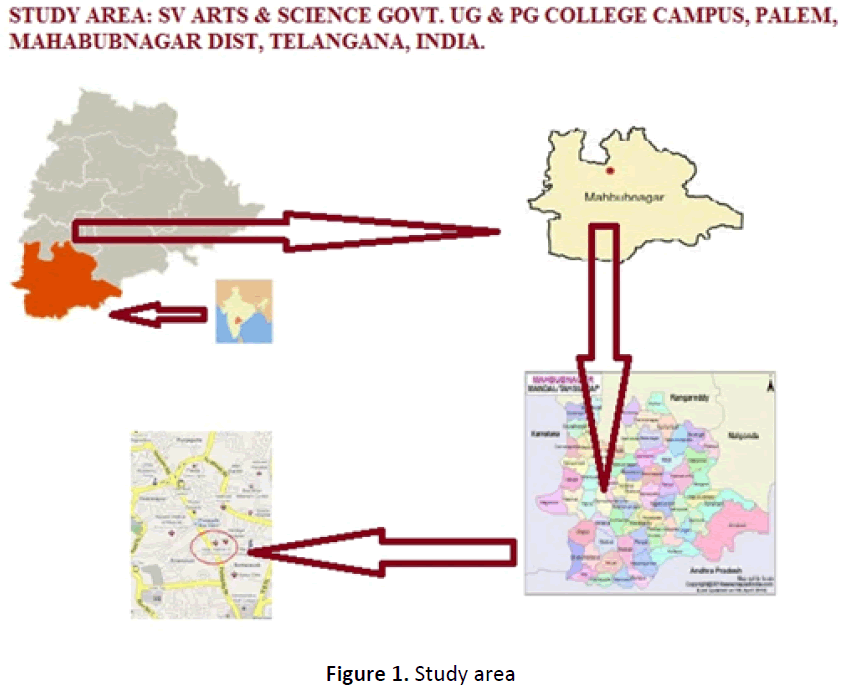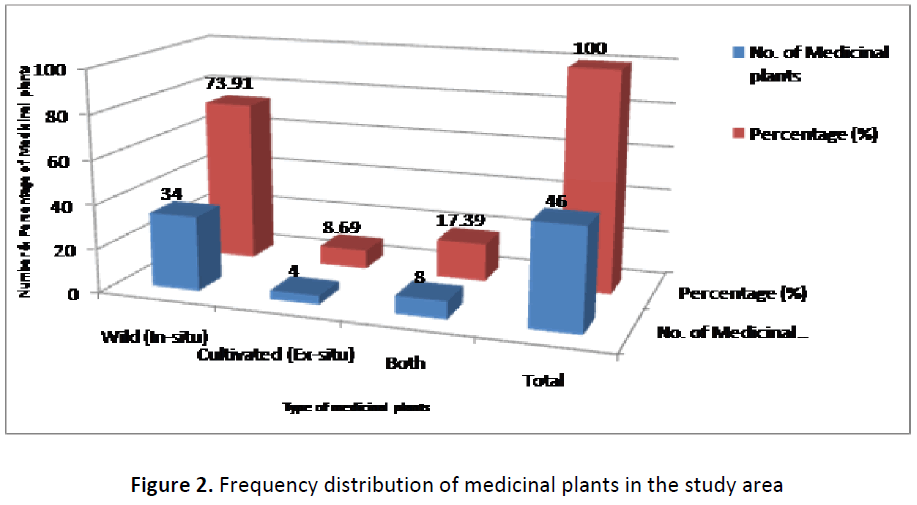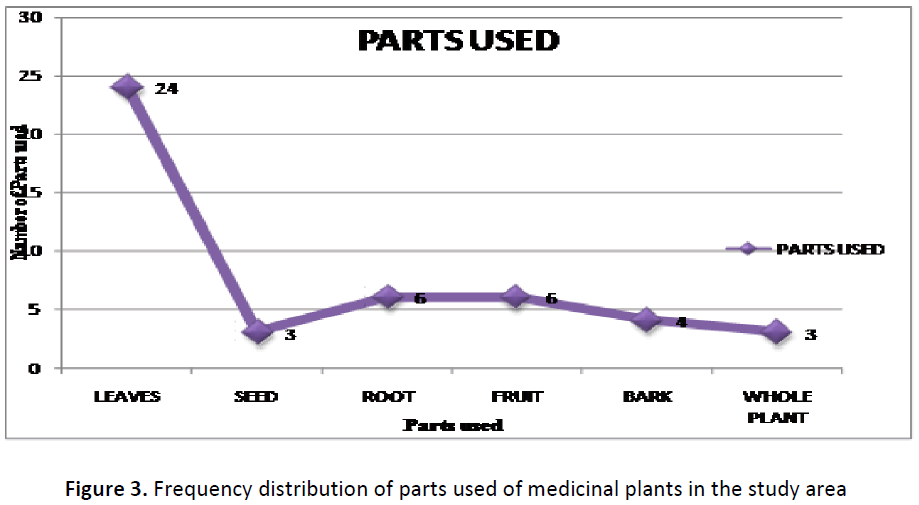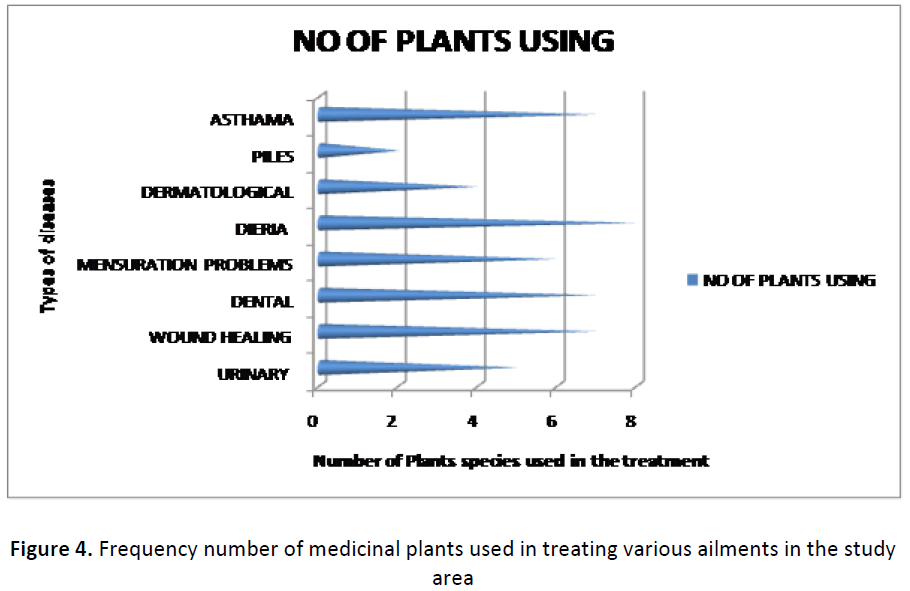ISSN : 2348-9502
American Journal of Ethnomedicine
Documentation of Medicinal Plants from SV Govt. Degree & PG College Campus Palem, Mahabubnagar Dist. Telangana, India
1SV Arts and science, Degree and PG College, Palem, Mahabubnagar, District, Telangana, India
2Dept. of PG Studies and Research in Botany, MVS Govt. Degree and PG College, Mahabubnagar, Telangana, India
Abstract
Objectives: Documentation of medicinal plants from the campus of SV Govt. Degree & PG College Palem. Methods: Regular field trips were conducted, the information about the plants was recorded using standard questionnaire with the informers. The collected plant specimens were authentically identified with the help standard of floras.
Results: A total about 46 medicinal plants species were documented from the study area. Of 46 plants species belonging to 44 genera and 23 families were found useful. The largest families Anacardiaceae, Cucurbitaceae, Fabaceae were represented 05 species followed by Euphorbiaceae 04 species Asteraceae 3 species. Whereas 09 families i.e., Acanthaceae, Amarathaceae, Cactaceae, Lamiaceae, Mimosaceae, Moraceae, Rutaceae, Sapindaceae, Solanaceae represented by 2 of each species. While the 11 families represented single species.
Concussion: The present documentation will be useful to the campus students for further research and field works.
Keywords
SV Govt. Degree & PG College campus, Medicinal plants, Mahabubnagar, Telangana.
INTRODUCTION
Man has been using plants from ancient time and research workers are constantly brings to light additional information on the relationship between plants and man. The theme of ethnobotany or folkloric botany reveals interrelation of plants and man. The field verge upon the study of ethnobotany plays imperative role because of the chance of direct contact that can be recognized with the genuine information on the use of plants, both wild and cultivated from the people.
The information of medicinal plants has been accumulated in the course of many centuries based on different Indian systems of medicines [1]. Drugs obtained from plant are believed to be much safer and exhibit a remarkable efficacy in the treatment of various ailments [2].
Indian traditional medicine is based on different systems such as Ayurveda, Siddha and Unani used by various communities [3]. Thus, there is now necessity for ethno-botanical research amongst indigenous people [4]. In recent years, customary ethnobotanical studies have received much concentration due to their wide local acceptability and clues for new or less known medicinal plants [5].
Today there is an increasing desire to unravel the role of ethnobotanical studies in trapping the centuries old traditional folk knowledge as well as in searching new plant resources of food, drug etc. [6,7]. People living in the developing countries rely quite effectively on traditional medicine for primary health care [8,9].
The study area having huge biodiversity but from here no one earlier reported on documentation of medicinal plants. The present report representing uniqueness.
In the present report an attempt has been made to document the medicinal plants flora of SV UG & PG College Palem, this will become source for further research and field studies of campus.
MATERIALS AND METHODS
Regular field trips were conducted in the study area (SV Govt. UG & PG College Palem, having 9 acres of black soil land Fig.1) during the period from June 2014 to Nov 2014. Campus surrounding localities were selected for the folkloric knowledge on medicinal plants documentation. During the fieldwork, frequent visits were made to the folkloric practitioners and efforts were made to convince them to disclose their folkloric knowledge about the healing plants. The information about the plants was recorded by means of discussions using standard questionnaire [10] with the informers along with the field visits during the collection hours. The documentation was done in the campus with the present of folkloric medicinal practitioner.
Figure 2: Frequency distribution of medicinal plants in the study area
Figure 3: Frequency distribution of parts used of medicinal plants in the study area
Figure 4: Frequency number of medicinal plants used in treating various ailments in the study area
The collected plant specimens were authentically identified with the help of floras such as, Flora of Andhra Pradesh [11], Flora of British India [12] and Flora of Gulbarga District [13], herbarium specimens were prepared and deposited in SV Arts and science, Degree and PG College, Palem, Mahabubnagar, District, Telangana, India.
RESULTS
During the documentation of medicinal plants perception from SV Govt. Degree & PG College campus 46 medicinal plants species were documented. Of 46 plants species belonging to 44 genera and 23 families were found useful. The largest families Anacardiaceae, Cucurbitaceae, Fabaceae were represented 05 species followed by Euphorbiaceae 04 species Asteraceae 3 species. Whereas 09 families i.e., Acanthaceae, Amarathaceae, Cactaceae, Lamiaceae, Mimosaceae, Moraceae, Rutaceae, Sapindaceae, Solanaceae, represented by 2 of each species. While the 11 families represented single species each i. e., Celastraceae, Cucurbitaceae, Liliaceae, Malvaceae, Myrtaceae, Oxalidaceae, Papaveraceae, Santalaceae, Scorphulariaceae, Zingiberaceae, Zygophyllaceae. While the 13 families represented single species each. In the following enumeration, the species are arranged alphabetically. The plant species are enumerated alphabetically by botanical name, family followed by plant part used (Table-1). The paper presents a brief account of the medicinal plants flora and their uses.
Table 1: Documented medicinal plant of SV Govt. Degree & PG College campus Palem, Mahabub nagar district, Telangana, India
| Family | Botanical name | Common name | Medicinal Property | Effective part |
|---|---|---|---|---|
| Acanthaceae | Adathoda Zeylanica Medic. | Adasaram | Asthma | Young leaves |
| Skin problems & Piles | Leaf | |||
| Andrographis paniculata (burm.f.) Wall. | Vasantha | Skin problems | Fruit | |
| Diarrhea & dysentery | leaves | |||
| Amarathaceae | Achyranthus aspera L. | Uthareni | Teeth pain | Roots |
| Diarrhea & dysentery | Leaves | |||
| Amaranthus spinosus L. | Mullu thota kura | Diarrhea & dysentery | Root | |
| Anacardiaceae | Mangifera indica L., | Mamidi | Menstrual disorder | Bark |
| Calotropis procera R. Br. | Jilledu | Menstrual disorder | Fruits | |
| Gymnema sylvestre (Retz.) R.Br.ex.Schult | Podapathri | Asthma | Fruit | |
| Hemidesmus indicus L., | Reddi | Teeth pain | Roots | |
| Tylophora indica (Brum.f.) Merrill. | Kakapala | Asthma | Root | |
| Asteraceae | Tagetes erecta L., | Banthi | Teeth pain | Leaf |
| Tridax procumbens L. | Nallalam | Cuts | Leaf | |
| Eclipta alba Hassk. | Galagara | Teeth pain | Leaves | |
| Cactaceae | Opuntia dillenii (Ker – Gawler) Haw., | Pampadga | Urinary disorders | Fruit |
| Carica papaya L. | Popai | Menstrual disorder | Fruit | |
| Celastraceae | Gymnosporia montana (Roth) Benth. | Dantha | Diarrhea & dysentery | Leaves |
| Cucurbitaceae | Coccinia indica Wt &Arn., | Advi donda | Urinary disorders | Root |
| Euphorbiaceae | Ricinus communis L., | Amudam | Urinary disorders | Root |
| Emblica officinalis Gaertn. | Usri | Asthma | Seeds | |
| Piles | Fruit | |||
| Euphorbia hirta L., | Nanabala | Asthma | Whole plant | |
| Diarrhea & dysentery | Whole plant | |||
| Phyllanthus niruri L., | Nelausri | Skin problems | Leaves | |
| Diarrhea & dysentery | Leaf | |||
| Fabaceae | Saraca asoca (Roxb) De Wilde | Asoka | Menstrual disorder | Bark |
| Diarrhea & dysentery | Flower | |||
| Tephrosia purpurea (L.) pears. | Vempalli | Menstrual disorder | Whole plant | |
| Cassia auriculata L. | Thangedu | Wound healing | Flowers | |
| Dolichas biflorous L., | Ulvalu | Piles | Seeds | |
| Cassia tora L., | Vanka thangedu | Teeth pain | Leaves | |
| Lamiaceae | Ocimum sanctum L., | Thulasi | Asthma | Fruits |
| Coleus aromaticus Benth. | Gunugu | Diarrhea & dysentery | Leaf | |
| Liliaceae | Aloe vera Mill. | kalabanada | Menstrual disorder | Aloe |
| Malvaceae | Abutilon indicum (L.) Sweet. | Wound healing | Leaves | |
| Mimosaceae | Mimosa pudica L., | Athipathi | Wound healing Diarrhea & dysentery | Leaf |
| Acacia nilotica (L.) DELLILE | Nallathumma | Skin problems | Leaves | |
| Moraceae | Ficus racemosa (L.) | Medi | Wound healing | Bark |
| Ficus bengalensis L. | Marri | Teeth pain | Bark | |
| Myrtaceae | Syzygium cumini (L.) Skeels. | Jaama | Menstrual disorder | Leaves |
| Oxalidaceae | Oxalis corniculata L., | Ambati kura | Wound healing | Whole plant |
| Papaveraceae | Argemone mexicana L. | Jeripothu alaam | Skin problems | Root |
| Rutaceae | Ruta chalepensis L., | Asthma | Leaves | |
| Murraya koenigii (L.) | Karepaku | Piles | Leaves | |
| Santalaceae | Santalum album L., | Chandanam | Skin problems | Wood |
| Sapindaceae | Dodonaea viscose (L.) Jacq. | Jadukattala | Wound healing | Root |
| Cardiospermum helicacabum L. | Allena | Diarrhea & dysentery | Leaves | |
| Scorphulariaceae | Digitalis purpurea | Ganneru adavi | Wound healing | Leaf |
| Solanaceae | Datura metal L. | Umetha | Menstrual disorder | Leaves & seeds |
| Solanum xanthocarpum Schard and Wendl. | Kukka vankaya | Teeth pain | Fruits & seeds | |
| Zingiberaceae | Curcuma longa L., | Pasupu | Wound healing | Leaves |
| Zygophyllaceae | Tribulus terrestris L., | Pallerukaya | Urinary disorders | Seeds |
The present documentation will be useful to the campus students for further research and field works.
DISCUSSION
Obtained present results were compared with the available literature and found that many of the usages listed are not recorded earlier [14-16]. However, the use of Oxalis corniculata L., whole for wound healing, root of Dodonaea viscose (L.) Jacq. to reduce wound healing, leaves of Cardiospermum helicacabum L. for Diarrhea & dysentery and the leaves of Digitalis purpurea for wounds were also not reported.
CONCLUSION
The documentation of medicinal plants flora is the only way to preserve the fundamental knowledge of the plant resources of the study area (campus). So it concluded that the present documentation will be useful to the campus students for further research and field works.
ACKNOWLEDGEMENT
Authors are grateful to the SV Govt. Degree & PG College ex-authority Palem, Mahabubnagar Dist. Telangana for conservation of medicinal plants, also thankful to folkloric people of Palem for sharing knowledge.
REFERENCES
- Pei SJ. Ethnobotanical approaches of traditional medicine studies: Some experiences from Asia. Pharmaceutical Biology. 2001; 39:74-79.
- Rao RR. Traditional knowledge and sustainable development: Key role of ethnobiologist. Ethnobotany. 1996; 8:14-24.
- Gadgil M. Documenting diversity: An experiment. Curr. Sci. 1996; 70(1):36.
- Maheshwari JK. Development in ethnobotany Editorial. J. Econ Taxon Bot. 1983; 4(1):1-4.
- Tripathi YC. Ethno medicinal treasure of tribal Rajasthan. J. Non-Timber for Products. 2000; 7(1- 2):77-84.
- Jain SK. A Manual of Ethnobotany. Scientific Publishers, Jodhpur 1987; India.
- Jain SK. Dictionary of Indian Folk Medicine and Ethnobotany. Deep Publications, 1991; New-Delhi.
- Sullivan K, Shealy CN. Complete Natural Home Remedies. Element Books Limited, Shaftsbury, 1997; UK.
- Singh JS. The biodiversity crisis. A multifaceted review. Curr. Sci. 2002; 82(6): 638.
- www.Indian ethnobotanicalsociety.blog.in 2010.
- Pullaiah T. Flora of Andhra Pradesh, New Delhi. Publishers, 2010.
- Gamble JS and Fisher CEC. Flora of Presidency of Madras, 1921; 1-3.
- Seetharam YN, Kotresh K, Upalaonkar SB. Flora of Gulbarga district 2000; (Gulbarga University, Gulbarga).
- Ravi Prasad Rao B, Sunitha S. Medicinal Plant Resources of Rudrakod Sacred Grove in Nallamalais, Andhra Pradesh, India. J Biodiversity. 2011; 2(2):75-89.
- Sudhakar Reddy C. Reddy KN. Thulsi Rao K, Chiranjibi Pattanaik. Ethnobotanical Studies on Medicinal Plants Used by the Chenchus of Nallamalais in Kurnool District, Andhra Pradesh, India” Res Journal of medicinal plants. 2007; 1(4):128-133.
- Dharmachandra Kumar T, Pullaiah T. Ethno – Medico – Botany of Chenchus of Mahabubnagar District, Andhra Pradesh, Anc Sci Life. 1999; 19(1-2):31–35.
Open Access Journals
- Aquaculture & Veterinary Science
- Chemistry & Chemical Sciences
- Clinical Sciences
- Engineering
- General Science
- Genetics & Molecular Biology
- Health Care & Nursing
- Immunology & Microbiology
- Materials Science
- Mathematics & Physics
- Medical Sciences
- Neurology & Psychiatry
- Oncology & Cancer Science
- Pharmaceutical Sciences




